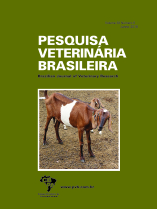 |
|
|
|
Year 2018 - Volume 38, Number 6
|

|
Serum biochemical profile of Pêga breed donkeys in the state of Minas Gerais, 38(6):1225-1231
|
ABSTRACT.- Santos J.B.F., Franco M.M., Antunes R.C., Guimarães E.C. & Mundim A.V. 2018. Serum biochemical profile of Pêga breed donkeys in the state of Minas Gerais. [Perfil bioquímico sérico de jumentos da raça Pêga no estado de Minas Gerais.] Pesquisa Veterinária Brasileira 38(6):1225-1231. Faculdade de Medicina Veterinária, Universidade Federal de Uberlândia, Avenida Pará 1720, bloco 2T, Uberlândia, MG 38400-902, Brazil. E-mail: joaos@ufu.br
For the evaluation of serum biochemical parameters of Pêga breed donkeys (Equus asinus), for the different age groups and sex, blood samples of 123 animals were analyzed, of 29 males aged from 8 days to 10 years and of 94 females (15 lactating) aged from 2 days to 12 years, from two farms in the central-southern Minas Gerais, Brazil. The donkeys were divided by age into 5 groups: Group 1 (≤6 months), Group 2 (7-12 months), Group 3 (13-48 months), Group 4 (49-72 months), and Group 5 (≥73 months). According to the sex, they were divided into two groups, males and females. Serum biochemical elements: total protein, albumin, globulin, the A:G ratio, cholesterol, triglycerides, uric acid, creatinine, urea, phosphorus, calcium, Ca:P ratio, magnesium, alanine aminotransferase (ALT), aspartate aminotransferase (AST), alkaline phosphatase (ALP), gamma glutamyl transferase (GGT) and creatine kinase (CK), were evaluated in all animals. No significant differences were found for globulins, uric acid, urea and A:G ratio between age groups. Group 4 showed the highest values for total protein when compared with animals in Group 1 and 2. In Goup 2, the donkeys showed albumin levels lower than Group 3 and 4. Group 1 they had cholesterol levels higher than those in Group 2 and 4, and similar of the other groups. Higher phosphorus serum concentration was observed in Group 1. Calcium was significantly lower in Group 2. The Ca:P ratio was higher for Group 5. The magnesium values were significantly higher in donkeys older than 49 months (Group 4 and 5). The value of AST was lower for group 1. The ALP enzyme was significantly higher in younger animals up to 12 months, followed by gradual decrease with advancing age. The values of GGT were higher in donkeys up to 6 months, followed by decreasing values for subsequent groups. No differences were found between genders for albumin, cholesterol, creatinine, urea, uric acid, Ca:P ratio, magnesium, ALT, AST, and alkaline phosphatase. Females had higher values for total protein, globulin and triglycerides. Males showed higher values for A:G ratio, phosphorus, calcium and CK. The results showed that age and sex can influence serum biochemical values of Pêga breed donkeys. |
| |
|
|
| |
|
 |